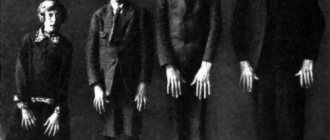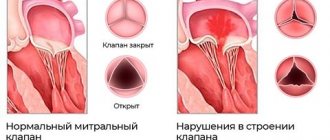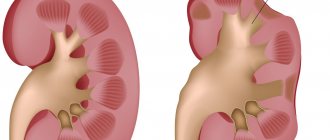Experts agree that isolating cyanosis into separate disorders is incorrect. Rather, it is a group of signs, visually expressed, combined for diagnostic purposes into a single group. Cyanosis is manifested by skin coloration that is different from normal. This is due to an increase in the amount of reduced (reduced) hemoglobin, which has a darker color.
Depending on the affected area, this may be:
- diffuse (generalized, extensive) cyanosis, when color changes throughout the body;
- local (peripheral) cyanosis or acrocyanosis.
If we can talk about this kind of phenomenon, cyanosis has its advantages. Firstly, it often becomes the only signal for urgent treatment of a critical pathology. Secondly, despite the severity of its symptoms, it is not accompanied by acute discomfort.
SYMPTOMATICS OF CUTANEOUS PHENOMENON AND ITS PROVOCATORS
There can be many provocateurs of cyanosis, but most often the color of the skin and membranes is observed with:
- diseases of the pulmonary-bronchial system (pleurisy, pneumothorax, pneumonia, asphyxia, emphysema, COPD, edema);
- critical pathologies of the heart and circulatory systems (embolism, myocarditis, endocarditis, tamponade).
By the way cyanosis spreads, one can judge its causative agent. Thus, gradual staining of the skin, starting from the membranes of the tongue, ears, face, indicates pathologies of the lungs or heart. Instantly developing cyanosis indicates toxic shock or anaphylaxis. With tamponade or thrombolism, cyanosis develops within 1-3 hours.
Color and distribution area
The color of the coat can indicate the need for urgent treatment.
- Red cyanosis is a sign of progressive diabetes. May indicate the need for treatment for polycythemia (a surplus of red blood cells) or cancer. Bright scarlet cyanosis of the face is a threat of developing oncology of the pituitary gland or adrenal glands.
- Dark purple color (ears, fingers, nose) is a sign of microthrombosis.
- Dark purple cyanosis accompanies pancreatitis.
- The orange color of the limbs (soles, palms) indicates cyanosis due to bleeding in the peritoneum.
The practice of treating diseases that are accompanied by cyanosis indicates that the proximity of the color to black-blue and violet more often indicates heart pathologies. The symptoms of the so-called blue disease – pulmonary artery stenosis – are separated into a separate block. There is also the concept of spotted cyanosis; it can signal vascular embolism, brain pathologies or hemorrhagic fever.
When blueness is concentrated in the extremities, the likelihood of treating thromboembolism increases. Or thrombosis of the main canals (with cyanosis with swelling of the limbs).
Diagnostics
Acrocyanosis and other varieties of this pathological condition are not a disease in themselves. This is just a symptom of a serious pathology in the body of a child or adult, so when such a symptom appears, diagnosis is important. First of all, if a child or adult has facial cyanosis, their respiratory system is checked, identifying the causes of the lack of oxygen in the blood. If a child is diagnosed with acrocyanosis, that is, blue discoloration of the limbs, mucous membranes, and nails, disorders in the functioning of the cardiovascular system are diagnosed first.
The main tests that are prescribed for patients with suspected acrocyanosis are:
- general blood test;
- blood gas analysis;
- blood flow velocity analysis;
- pulse oximetry.
Pulse oximetry
Then, taking into account complaints and symptoms, as well as test data, research methods such as electrocardiography, chest CT, chest x-ray may be prescribed.
METHODOLOGY FOR STUDYING PATHOLOGICAL SKIN COLORING
Recognition of cyanosis comes down to differential analysis and verification of the provocateur (the disease against which cyanosis occurred, requiring treatment). At the first level, cyanotic pigmentation is distinguished from related pathologies - methemoglobinemia and carboxyhemoglobinemia.
To do this, blood is taken (it may contain toxins that cause one of three pathologies). For verification and “targeted” treatment, the following can be carried out:
- capillaroscopy;
- UAC;
- spectrophotometry;
- study of blood gases (arterial);
- pulse oximetry;
- measurements of PaO2 and SaO2;
- refined assay for the identification of hemoglobin derivatives.
To exclude (confirm for the purpose of treatment) OD pathologies, X-rays, chest CT and spirometry are performed. To exclude (or clarify and begin treatment) heart disease, you need an ECG / EchoCG, sometimes an MRI or scintigraphy.
Kinds
Before prescribing treatment, the specialist must accurately determine the type of pathology. Based on their origin, the following types of cyanosis are distinguished:
- Cordial. Weakened blood flow and inadequate nutrition of tissues - not enough blood and oxygen reach them.
- Respiratory. Oxygen starvation of the lungs and failure of oxygen supply to almost all tissues and organs.
- Cerebral. Oxygen does not attach to hemoglobin, causing ischemia of brain cells.
- Metabolic. Tissue cells cannot absorb oxygen properly.
- Hematological. Caused by blood diseases.
Ten minutes of oxygen therapy is generally sufficient to eliminate respiratory cyanosis. Other types do not go away so easily and require a competent approach to treatment.
The nature of the spread of pathology varies, so experts distinguish:
- How to raise hemoglobin using folk remedies - 7 proven recipes
- Central cyanosis or diffuse cyanosis. Localized throughout the body, it is provoked by a failure of breathing or the entire blood flow.
- Peripheral. For problems with the performance of the heart, arteries, or the development of oxygen starvation of the limbs or face.
- Acrocyanosis. Only the skin on the fingers, on the edge of the nose, around the lips becomes bluish, which occurs due to stagnation of blood in the veins.
- Local. This type is determined when the mucous membranes and genitals are examined. Caused by stagnation of blood.
Cyanosis manifests itself in different ways, so it can be in acute, subacute and chronic forms.
HOW TO GET RID OF CYANOSIS?
The treatment tactics for cyanosis always come down to three levels of exposure.
- Urgent identification of the provocateur and treatment of critical illness.
- Oxygen treatment (cocktails, tents, procedures).
- Maintenance treatment. This includes exercises, aqua physiotherapy, massage.
Actually, the treatment of cyanosis is based on the elimination of hypoxia - oxygen deficiency in the blood transport system. Treatment should be carried out with mandatory procedural oxygen support and LOP. The patient himself must comply with a number of conditions for treatment of both the related and the underlying disease.
The first is giving up dangerous habits (alcohol, smoking) - treatment of cardiac and respiratory mechanisms without this is ineffective. The second is building a rest schedule (here – treatment through auto-training and self-massage). Third, a strict treatment regimen for the underlying disease (antibacterial, anti-inflammatory therapy).
Physiopathological mechanisms
From a physiopathogenetic point of view, cyanosis is caused by three mechanisms:
- Systemic oxygen desaturation : a problem with the lungs (asthma, COPD, lung cancer...) or the heart (heart diseases of various types) can lead to insufficient concentration of oxyhemoglobin in the arterial blood (due to low oxygen, Hb decreases).
- Slowing of peripheral circulation , due to circulatory problems (eg, varicose veins, atrial fibrillation, heart failure), an increased release of oxygen from part of the peripheral tissues may occur.
- Generalized cyanosis may occur during certain poisonings (drugs/toxins or metals such as silver or lead, carbon monoxide poisoning), producing abnormal hemoglobin compounds such as methemoglobin or sulfoemoglobin.
Based on these causal mechanisms, two main types of cyanosis have been described:
- central cyanosis (affects the entire body);
- peripheral cyanosis (affects only the limbs or fingers).
Cyanosis may be limited to only one area of the body, such as the limbs, in which case it is associated with local circulatory problems.
- Reactive arthritis - approaches to diagnosis
Some dermatological conditions can cause skin discoloration that mimics cyanosis, even when there is sufficient oxygen in the capillary beds.
Cyanosis can also be caused by external factors such as high altitude (because there is "less oxygen" in the air) or exposure to cold air or water, which causes vasoconstriction.
Central cyanosis
Central cyanosis often occurs due to problems with the circulation or lungs, resulting in poor oxygen saturation of the blood. It develops when the concentration of deoxygenated hemoglobin (low Hb = not oxygenated) is equal to or greater than 5 g/100 ml.
Risk group
People most often affected by cyanosis are:
- abuse alcohol;
- smoke a lot;
- do not eat properly, eat a lot of fatty foods (cholesterol levels increase);
- experience severe emotional shocks and are in a state of stress for a long time;
- suffered leg injuries;
- suffer from hypertension, diabetes mellitus;
- frostbitten limbs;
- suffer from varicose veins;
- little rest.
Elderly or, conversely, childhood and pregnancy are also risk factors for the development of cyanosis.
Pathogenesis
The ways in which acrocyanosis occurs are not fully understood. In the primary version, a bluish coloration of the skin is possible due to impaired vascular function of small arterioles or venules.
In the secondary version, the development of acrocyanosis depends on its cause. Sometimes the pathology is associated with increased blood viscosity. In other cases, the mechanism of its development is associated with dysregulation of vascular tone and the accumulation of toxins, for example, methemoglobin.
The exact mechanisms at the molecular level in acrocyanosis, as well as, for example, in Raynaud's syndrome, remain to be understood. Alpha-adrenergic receptors of the vascular wall, serotonin and other nerve endings may be involved in the development of pathology.
The microscopic picture of tissues with acrocyanosis has the following signs:
- local edema with dilation of superficial capillaries;
- sometimes – the formation of new vessels;
- slight accumulations of lymphocytes around the vessels;
- an increase in the size and number of arteriovenous anastomoses (communications) bypassing the capillary bed;
- abnormally located collagen fibers.
Similar microchanges are visible in unchanged skin in patients with Ehlers-Danlos syndrome. At the same time, many cases of this syndrome are accompanied by acrocyanosis. Thus, this disorder is an inherited vascular dysfunction.
Primary acrocyanosis
This condition has been little studied. It is believed that it is associated with a violation of the tone of the smallest blood vessels - capillaries. With primary acrocyanosis, the pressure in them is reduced and the blood flow is slowed down. Compared to Raynaud's phenomenon, there is almost no improvement in blood flow when the extremities are warmed. Also in the primary form, the influence of neurotransmitters, impaired tone (expansion) of venules, and insufficient enrichment of blood with oxygen is discussed.
Secondary acrocyanosis
This pathology is caused by various reasons and mechanisms:
- allergic reactions lead to persistent expansion of capillaries and venules;
- the use of tricyclic antidepressants leads to an imbalance between H1- and H2-histamine and adrenergic receptors;
- arsenic poisoning leads to the formation of intravascular blood clots, which often cause limb amputation;
- acrocyanosis in malignant tumors is caused by increased blood viscosity and the proliferation of cellular elements of the vascular wall, this causes the specific “earthy” complexion of cancer patients;
- with anorexia nervosa, a persistent violation of thermoregulation occurs with a delayed response to vasoconstrictor and vasodilator stimuli.
Diagnosis of cyanosis
diagnosing a disease involves performing a blood test to detect pathological derivatives of hemoglobin
When diagnosing cyanosis, it is worth paying attention to the following indicators:
time of onset of symptoms - time of taking medications or contact with substances that lead to the formation of pathological derivatives of hemoglobin - signs of central and peripheral wow cyanosis. Symptoms of diseases of the cardiovascular and respiratory systems indicate central cyanosis, and if during massage or slight warming of the limb the skin blood flow increases, then the periphery erical cyanosis will disappear, and central cyanosis - no presence or absence of tympanic club syndrome - occurs as a result of fusion of connective tissue, which leads to to thickening of the distal phalanges of the fingers and toes - blood analysis and other studies aimed at identifying pathological derivatives of hemoglobin.
If cyanosis of the nasolabial triangle has been noticed in children, it is worth contacting a pediatrician and undergoing the necessary examinations, consulting with a children's cardio-rheumatologist and performing an ultrasound sound examination of the heart. You also need to do an ultrasound of the thymus gland and contact a pediatric neurologist and take a blood test. Very often, cyanosis of the nasolabial triangle in newborns also occurs in absolutely healthy children. The skin of children is quite thin, and the venous plexuses seem to “see through” the skin. If a child develops symptoms of this disease and is not caused by some event or disease, as well as prolonged cooling, you should immediately consult a doctor to determine the circumstances.
In women, cervical cyanosis or vaginal cyanosis may be one of the signs of pregnancy. It is worth taking a pregnancy test and contacting a gynecologist for an examination.








